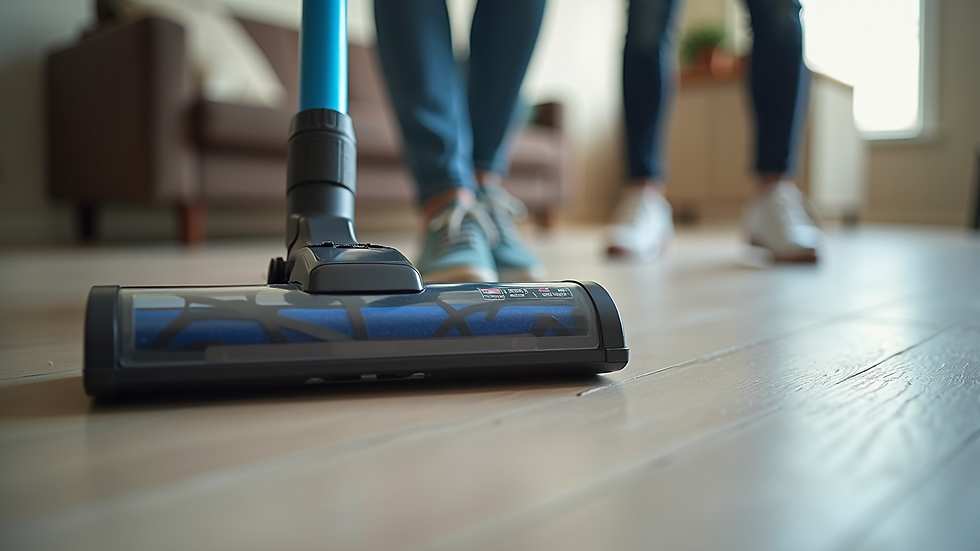Maximizing Cleanliness: Low Moisture Carpet Cleaning - Best for Allergies
- C N

- Mar 28
- 4 min read
As spring arrives, the beauty of blooming flowers and sunshine draws us outdoors. Yet, for many, this season brings sneezing and sniffling, thanks to pollen and dust lurking in our homes. For individuals with allergies, maintaining a clean indoor atmosphere is crucial, especially when it comes to carpets, which can trap irritants and allergens. Traditional carpet cleaning techniques often rely on a lot of water, which may lead to mold and mildew if the carpets do not dry quickly. This is where low moisture carpet cleaning shines.
In this post, we will delve into practical low moisture carpet cleaning tips that help you maintain cleanliness and alleviate allergy symptoms this spring.
Understanding Low Moisture Carpet Cleaning And Why It's Best For Allergies
Low moisture carpet cleaning uses minimal water during the cleaning process. Unlike traditional steam cleaning that can soak carpets, these techniques employ specialized cleaning solutions and tools to lift dirt and allergens without saturating the fabric. A powerful statistic to consider: carpets can take up to 24 hours to dry using conventional methods, while low moisture methods typically allow carpets to dry in just 30 minutes. This significant reduction in drying time helps prevent the development of mold, creating a healthier indoor space.
Moreover, the air quality in your home improves as allergens are effectively removed, making low moisture carpet cleaning beneficial for health-conscious homeowners, and best for allergy sufferers.
Benefits of Low Moisture Carpet Cleaning for Allergies
Quick Drying Time
With low moisture cleaning, carpets dry in as little as 30 minutes, compared to 24 hours or more with traditional methods. This quick drying time helps prevent mold and allows you to return to your normal routine without lengthy interruptions.
Reduction of Allergens
Low moisture cleaning techniques can decrease allergens by as much as 95%, thanks to specialized equipment designed to break down dust mites, pollen, and pet dander that get trapped in carpet fibers. This means allergy sufferers can breathe easier in their own homes.
Enhanced Carpet Longevity
Traditional cleaning methods can compromise carpet fibers due to excessive water usage. In contrast, low moisture methods help maintain the structure and appearance of your carpets, potentially extending their lifespan by up to 30% according to some industry studies.
Essential Low Moisture Carpet Cleaning Tips
1. Use the Right Equipment
Choosing an effective low moisture carpet cleaning machine can transform your cleaning routine. Machines that utilize rotary brushes or cleaning pads can provide a deep clean while minimizing water usage.

Before making a purchase, consider researching models that have strong customer reviews focusing on allergy relief. Alternatively, renting a machine can give you a hands-on experience before committing.
2. Opt for Environmentally-Friendly Cleaning Solutions
When selecting a cleaning solution, choose eco-friendly options formulated for low moisture cleaning. These environmentally-conscious products are less likely to trigger allergic reactions and come without harsh chemicals.
For tough stains, pre-treat them with non-toxic stain removers. Always check product labels to ensure they do not contain artificial fragrances or irritants that could exacerbate allergies.
3. Regular Vacuuming
Vacuuming regularly is essential for controlling allergens in your carpets. Use a vacuum equipped with a HEPA filter, which effectively traps small particles like pollen and dust mites. Aim to vacuum at least once a week, increasing frequency during high pollen periods.
A vacuum with rotating brushes can also enhance cleaning efficiency, pulling out embedded dirt and allergens that a standard vacuum might miss.
4. Schedule Professional Low Moisture Cleaning
While DIY methods can be effective, professional low moisture cleaning services should be scheduled at least once a year. Professionals like Quik-Dry Inc. have training and access to advanced equipment that can extract deeply embedded allergens and contaminants.
Before booking, ask about their cleaning methods and products to ensure they align with your allergy management strategy.
5. Maintain Indoor Humidity Levels
Managing humidity in your home is essential for reducing allergies. Keep indoor humidity between 30% and 50% to deter dust mites and mold growth. During high-humidity months, consider using dehumidifiers.
Make sure that your carpets and upholstered furniture are well-ventilated. This simple practice helps prevent excess moisture from creating a breeding ground for allergens.
6. Consider Area Rugs and Mats
If you struggle to maintain your entire carpet, incorporating area rugs and mats in high-traffic areas is a smart choice. These can be easily cleaned and help prevent allergens from embedding themselves into your carpets.
Choose rugs made from natural fibers like cotton or wool, as these materials tend to trap fewer allergens. Remember to vacuum and wash these area rugs regularly to keep your space clean.
Revitalize Your Indoor Environment this Spring
Spring is a wonderful opportunity to breathe new life into your living spaces and tackle hidden allergens in your carpets. By employing low moisture carpet cleaning methods, you not only ensure that your carpets maintain their beauty but also significantly enhance your indoor air quality, reducing allergy symptoms.
Invest in the right equipment, select eco-friendly cleaning products, and commit to a regular cleaning routine. These proactive steps will help you create a clean, fresh, and healthier living environment, allowing you to fully enjoy the joys of spring.

Remember, keeping a clean home can greatly enhance your well-being, especially during allergy season. Embrace the freshness of spring while ensuring your indoor environment is clean and allergen-free!


